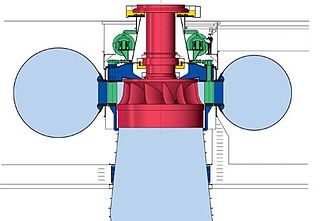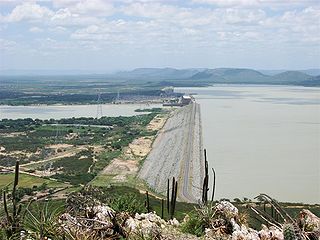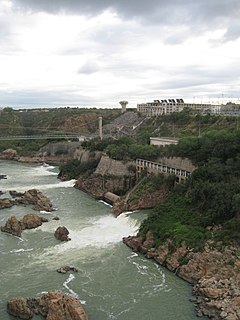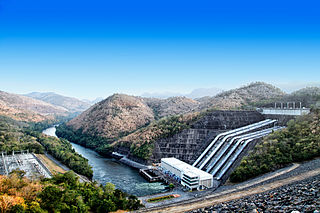| Luiz Gonzaga Dam | |
|---|---|
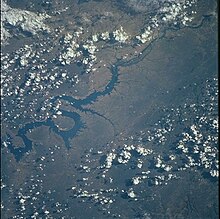 NASA image of Luiz Gonzaga (Itaparica) Reservoir in 2001, dam at bottom left | |
| Official name | Hidroelétrica de Luiz Gonzaga |
| Location | Petrolândia, Pernambuco, Brazil |
| Coordinates | 9°8′38″S38°18′48″W / 9.14389°S 38.31333°W Coordinates: 9°8′38″S38°18′48″W / 9.14389°S 38.31333°W |
| Construction began | 1979 |
| Opening date | 1988 |
| Owner(s) | CHESF |
| Dam and spillways | |
| Type of dam | Embankment, earth and rock-fill |
| Impounds | São Francisco River |
| Height | 105 m (344 ft) |
| Length | 4,700 m (15,400 ft) |
| Width (crest) | 10 m (33 ft) |
| Spillway type | Service, gate-controlled |
| Reservoir | |
| Creates | Luiz Gonzaga Reservoir |
| Total capacity | 10.7 km3 (8,700,000 acre⋅ft) |
| Catchment area | 630,000 km2 (240,000 sq mi) |
| Surface area | 830 km2 (320 sq mi) |
| Power Station | |
| Commission date | 1988-1990 |
| Turbines | 6 x 246.6 MW (330,700 hp) Francis turbines |
| Installed capacity | 1,479 MW (1,983,000 hp) MW |
The Luiz Gonzaga Dam, formerly known as the Itaparica Dam, is a rock-fill embankment dam on the São Francisco River 25 kilometres (16 mi) downstream of Petrolândia in Pernambuco, Brazil. The dam was built for navigation, and hydroelectric power generation as it supports a 1,479 megawatts (1,983,000 hp) power station. It was constructed between 1979 and 1988; the last of its generators was commissioned in 1990.
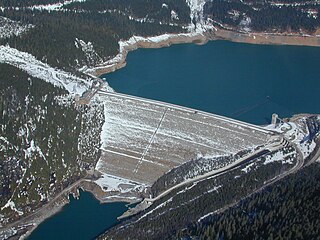
An embankment dam is a large artificial dam. It is typically created by the placement and compaction of a complex semi-plastic mound of various compositions of soil, sand, clay, or rock. It has a semi-pervious waterproof natural covering for its surface and a dense, impervious core. This makes such a dam impervious to surface or seepage erosion. Such a dam is composed of fragmented independent material particles. The friction and interaction of particles binds the particles together into a stable mass rather than by the use of a cementing substance.

The São Francisco River or Rio São Francisco is a river in Brazil. With a length of 2,914 kilometres (1,811 mi), it is the longest river that runs entirely in Brazilian territory, and the fourth longest in South America and overall in Brazil. It used to be known as the Opara by the indigenous people before colonisation, and is today also known as Velho Chico.

Petrolândia is a municipality in the state of Pernambuco, Brazil. It is in the São Francisco Region. Petrolândia has a total area of 1056.6 square kilometers and had an estimated population of 32.568 inhabitants in 2009 according to the IBGE. It has one of the largest GDP per capita of Sertão due to the location of one hydroelectric power plant, property of CHESF.
Contents
The dam is owned and operated by CHESF and was renamed in honor of Luiz Gonzaga, known as the "king of Baião" and "Gonzagão" [1] [2] [3]

Luiz Gonzaga do Nascimento, Sr., "The King of Baião" or "Gonzagão" was a Brazilian singer, songwriter, musician and poet and one of the most influential figures of Brazilian popular music in the twentieth century. He has been credited for having presented the rich universe of Northeastern musical genres to all of Brazil, having created the musical genre baião and has been called a "revolutionary" by Antônio Carlos Jobim. According to Caetano Veloso, he was the first significant cultural event with mass appeal in Brazil. Luiz Gonzaga received the Shell prize for Brazilian Popular Music in 1984 and was only the fourth artist to receive this prize after Pixinguinha, Antônio Carlos Jobim and Dorival Caymmi. The Luiz Gonzaga Dam was named in his honor.
The baião is a Northeast Brazilian rhythmic formula that became the basis of a wide range of music. Forró and coco are clear examples. The main baião instrument is the zabumba, a flat, double-headed bass drum played with a mallet in one hand and stick in the other, each striking the opposite head of the drum.



